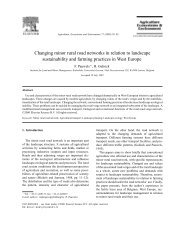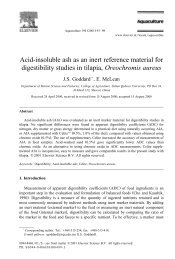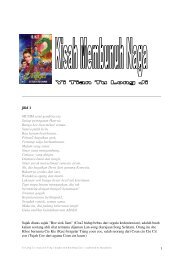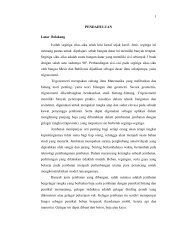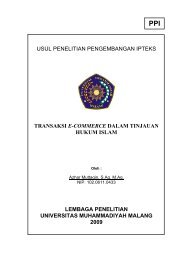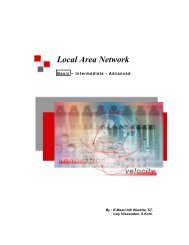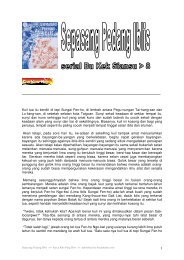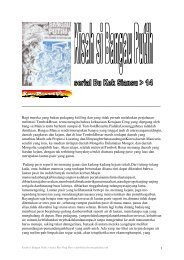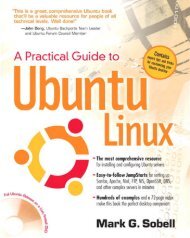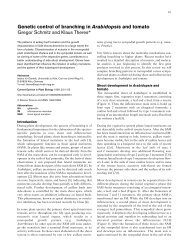Integrated online marketing communication ... - Directory UMM
Integrated online marketing communication ... - Directory UMM
Integrated online marketing communication ... - Directory UMM
Create successful ePaper yourself
Turn your PDF publications into a flip-book with our unique Google optimized e-Paper software.
JCOM<br />
12,2<br />
178<br />
(1) the fragmentation of audiences and <strong>communication</strong> contexts requires the<br />
customisation of <strong>online</strong> <strong>marketing</strong> messages; but<br />
(2) the interactivity, transparency and memory of the web necessitates the<br />
consistency of <strong>communication</strong> and the coherence of the transmitted meaning.<br />
A new strategic model has to be adopted by any organisation that attempts to present<br />
a coherent corporate identity in the <strong>online</strong> environment. The integrated <strong>marketing</strong><br />
<strong>communication</strong> is the primary instrument to achieve this objective. However, the<br />
implementation of the IMC concept will have to accommodate the specific<br />
characteristics of the internet, using the technological capabilities of the new<br />
medium to solve the specific challenges raised by the <strong>online</strong> environment and<br />
audiences.<br />
A model for implementing integrated <strong>online</strong> <strong>marketing</strong> <strong>communication</strong><br />
Based on the analysis of the specific characteristics of the <strong>online</strong> environment,<br />
applications, and audiences, a tentative model of integrated <strong>online</strong> <strong>marketing</strong><br />
<strong>communication</strong> is proposed in this study. The model was designed and then refined as<br />
a result of the direct interaction and debate with 29 <strong>marketing</strong> or <strong>communication</strong><br />
managers directly responsible for the <strong>online</strong> <strong>communication</strong> strategy of their<br />
companies.<br />
The messages send by the company to its <strong>online</strong> audiences have to be<br />
transformed/adapted in a three-stage process. First, the message should respect and<br />
integrate the core corporate values of the organisation. Second, the message has to be<br />
adapted in relation to the strategic and tactical objectives pursued through the <strong>online</strong><br />
<strong>communication</strong> campaign. Third, the message should be transformed considering the<br />
specific characteristics of the targeted audience/channel. In the case of <strong>online</strong><br />
<strong>communication</strong>, although the internet can be considered as the main channel of<br />
<strong>communication</strong>, there are, in fact, various <strong>online</strong> applications or modalities of<br />
<strong>communication</strong> that can be combined and used as an <strong>online</strong> <strong>communication</strong>-mix (email,<br />
chat, web site, discussion forums, etc.). The <strong>online</strong> <strong>communication</strong> channels vary in<br />
terms of their degree of transparency, interactivity, memory and selectivity, and these<br />
dimensions should be taken into account when establishing the proper <strong>communication</strong><br />
mix for each targeted audience.<br />
This process of message adaptation will preserve a flexible balance between<br />
continuity and customisation, the consistency of the adapted <strong>communication</strong> being<br />
determined by the integration of the corporate core values in the structure of each<br />
message.<br />
The respondents have also confirmed the tendency to integrate <strong>marketing</strong> and PR<br />
<strong>communication</strong> functions in the messages transmitted <strong>online</strong>, although there have been<br />
different opinions regarding the intensity of this integration (see Figure 1).<br />
On the other hand, the interactive dimension of the internet forces the firm to adopt<br />
a more proactive attitude in searching, registering, and analysing the direct and the<br />
indirect feed-back transmitted by the targeted audiences – or even, in some cases, by<br />
all categories of relevant audiences connected to the internet (considering the<br />
transparency and the memory of the internet, even un-targeted audiences can read and<br />
react to some of the <strong>online</strong> corporate messages).



